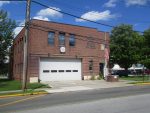Mt. Kisco Decides on Additional $4M Bond for Firehouse Work
Mount Kisco officials have agreed to place a $4 million referendum on the November ballot to pay for scaled-back expansion and renovation of the municipality’s three firehouses after learning the village’s engineering firm miscalculated project estimates.

If approved by voters, the extra money would be added to the $10.25 million voters authorized officials to borrow in 2017.
Mayor Gina Picinich said the Village Board met with the Board of Fire Commissioners on Aug. 1 to make a final decision on how much additional money was needed. With the change in the law approved earlier this year by the state legislature that pushed up election deadlines, Aug. 5 was the deadline for Mount Kisco to include the referendum on the general election ballot, she said.
Based on the revised calculations, the original bond would have fallen far short of the amount needed to complete even the most urgent work at the Green Street, Main Street and Lexington Avenue firehouses.
“They’ve now had to say that we needed all the things that were included in the initial scope of this project but clearly that’s more money and we don’t want to put that big a burden on taxpayers,” Picinich said of the commissioners.
In February, board members were informed by H2M architects + engineers that because the company had erred in calculating square footage at the Green Street, Main Street and Lexington Avenue firehouses, the original project would have cost the village millions more than it had anticipated spending. Factoring in cost escalation, the original design would have come to roughly $18 million.
Picinich said the reduced scope of the work would be “absolutely mission critical.” The initial designs included making the three facilities ADA compliant, adding energy efficiencies to the structures, expanding the bays and adding office space and training areas.
The fire department will likely cut back on the offices and the training areas, she said.
“It’s not a luxury but if something’s got to give that’s what’s going to have to fall back,” the mayor said. “But things like ADA compliance, things like expansion of the bays for equipment, things like making space so firefighters can actually stand in a safe space while putting on their equipment, these are absolutely mission critical.”
Deputy Mayor Jean Farber said there would have to be a roughly 20 percent reduction in the scope of the work at each of the firehouses. Trustees looked to the fire commissioners for guidance on how much extra money should be requested, she said. Originally, the commissioners wanted to ask the public for the additional $8 million, Farber said.
“We wanted the fire commissioners to make the decision on how much they want to ask from the public and we would support any amount they wanted,” Farber said.
Frank Mannion, chairman of the Board of Fire Commissioners, said fire officials looked to balance the needs of the department and the community.
“Understanding the financial impact to taxpayers was a major consideration in our decision making,” Mannion said. “Our volunteer firefighters live in our community. We bear the financial burden the same as every other taxpayer.”
Should the public vote in favor of the proposition, it will come with a cost. According to estimates from the village, the average homeowner with a current home market value of $413,000 would see a $122 increase in Fiscal Year 2020-21, or about 3.52 percent from the bond alone. The following two years would see increases of about 2 percent, or $71 and $72, respectively.
For each of the remaining 12 years of the 15-year bond, there would be a projected 1 percent tax increase as a result of the bond, Picinich said. Should there be higher revenues for the village than projected, the increases could be reduced, she said.
Farber added that the extra borrowing will ensure that the village would exceed the tax cap in the upcoming years.
The village expects to be compensated by H2M for any additional costs it will incur for redesigning the plans, going out for an additional bond and any other costs associated with going out for a second bond, Picinich said.
“There are going to have to be revisions to all of the plans,” she said. “We have every expectation that they will foot the bill for that. So everything associated with a damage, we have every expectation they will compensate us for this.”

Martin has more than 30 years experience covering local news in Westchester and Putnam counties, including a frequent focus on zoning and planning issues. He has been editor-in-chief of The Examiner since its inception in 2007. Read more from Martin’s editor-author bio here. Read Martin’s archived work here: https://www.theexaminernews.com/author/martin-wilbur2007/
